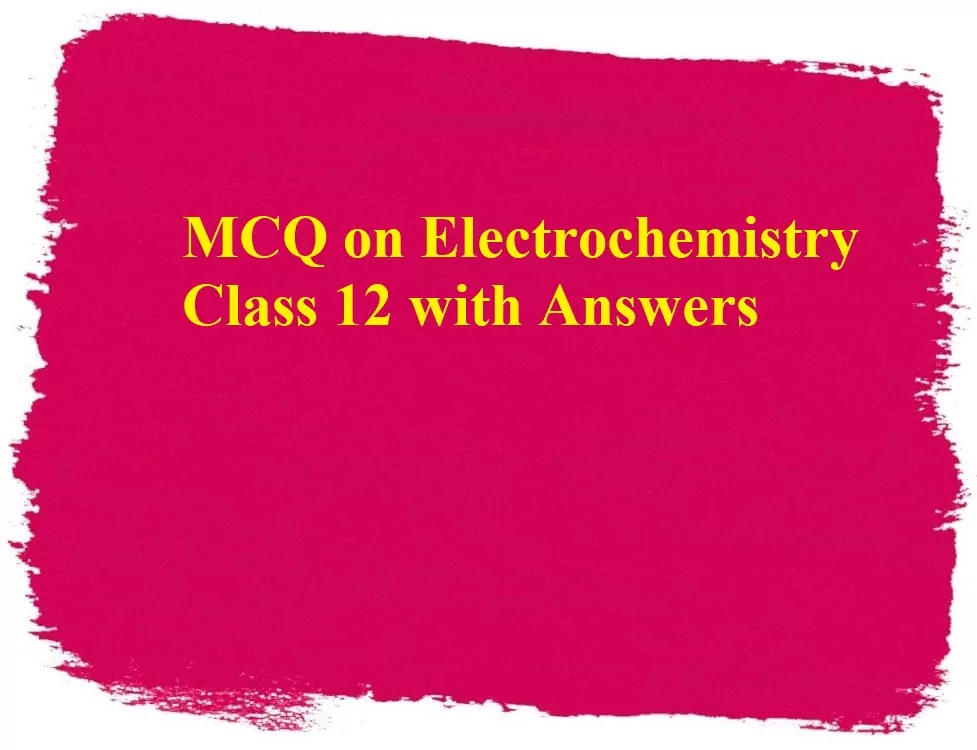MCQ on Electrochemistry Class 12 with Answers
MCQ on Electrochemistry Class 12 with Answers
Que 1. When the sample of copper with zinc impurity is to be purified by electrolysis, the appropriate electrodes are
Cathode Anode
(a) Pure zinc Pure copper
(b) Impure sample Pure copper
(c) Impure zinc Impure sample
(d) Pure copper Impure sample
Ans 1. (d)
Reason: Impure metal made anode while pure metal made cathode
Que 2. In the electrolytic cell, the flow of electrons is from
(A) Cathode to the anode in the solution
(B) Cathode to the anode through external supply
(C) Cathode to the anode through the internal supply
(D) Anode to the cathode through the internal supply
Ans 2. Cathode to the anode through the internal supply
Reason: In an electrolytic cell, cathode acts as a source of electrons.
MCQ on Electrochemistry Class 12 with Answers
Que 3. During the electrolysis of a solution of AgNO3, 96500 coulombs of charge pass through the electroplating both, the mass of silver deposited in the cathode will be
(A) 1.08 g (B) 10.8 g (C) 21.6 g (D) 108 g
Ans 3. (b)
Reason: Ag+ + e— → Ag,
96500 C will liberate silver = 108 gm.
9650C will liberate silver = 10.8 g
Que 4. The standard emf of a cell, involving one electron change is found to be 0.591 V at 25°C. The equilibrium constant of the reaction is (F = 96500 C mol–1)
(a) 1.0 × 101 (b) 1.0 × 105
(c) 1.0 × 1010 (d) 1.0 ×1030
Ans 4. (c)
Reason: The E°cell is given by
MCQ on Electrochemistry Class 12 with Answers
Que 5. For the galvanic cell Zn | Zn2+ (0.1M) || Cu2+ (1.0 M)|Cu the cell potential increase if:
(a) [Zn2+] is increased (b) [Cu2+] is increased
(c) [Cu2+] is decreased (d) surface area of anode is increased
Ans 5. (b)
Reason: For the given cell

The cell potential will decrease with increase in [Zn2+(aq)] and will increases with increase in [Cu2+(aq)]
Que 6. Consider the following cell reaction:
2Fe(s) + O2 (g) + 4H+ (aq) → 2Fe2+ (aq) + 2H2O(l)
E0 = 1.67V At [Fe2+] = 10–3 M, p(O2) = 0.1 atm and pH = 3, the cell potential at 25ºC is
(a) 1.47 V (b) 1.77 V
(c) 1.87 V (d) 1.57 V
Ans 6. (d)
Reason: Here n = 4, and [H+] = 10–3 (as pH = 3) Applying Nernst equation
Que 7. The cell constant of a conductivity cell ___________.
(a) changes with the change of electrolyte.
(b) changes with the change of concentration of electrolyte.
(c) changes with the temperature of the electrolyte.
(d) remains constant for a cell.
Ans 7. (d)
Reason: Remains constant for a cell.
MCQ on Electrochemistry Class 12 with Answers
Que 8. Faraday’s law of electrolysis are related to the:
(a) Atomic number of the cation
(b) the atomic number of the anion
(c) the equivalent weight of the electrolyte
(d) speed of the cation
Ans 8. (c)
Reason: Faraday’s laws of electrolysis states that 96500 coulombs of charge is needed to deposit one gm equivalent of an element at the electrode. So, it is related to the equivalent mass of electrolyte.
Que 9. The charge required for the reduction of 1 mol of MnO4– to MnO2 is:
(a) 1 F (b) 3 F (c) 5 F (d) 4 F
Ans 9. (b)
Reason: MnO4– → MnO2
The oxidation number of Mn in MnO4–,
⇒x=7
The oxidation number of Mn in MnO2,
⇒x−4=0
∴ Change in
Hence, the charge required will be .
Que 10. Electrolysis of aq. CuSO4 produces:
(a) an increase in pH
(b) a decrease in pH
(c) either decrease or increase
(d) H2SO4 in the solution
Ans 10. (b)
Reason: After the electrolysis i.e. the process in which electric current is passed through an aqueous solution of some compound or elements which leads to breakdown into anions and cations.
The copper sulphate solution will break down into Cu2+ cation and SO4−2 anion.
As a result, the solution of copper sulphate which is blue in colour will no longer retain. This SO4−2 combines with H2 and increases the acidity.
MCQ on Electrochemistry Class 12 with Answers





